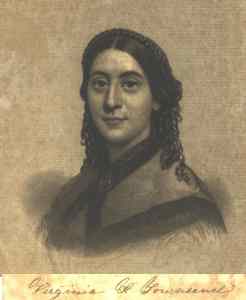Virginia Frances Townsend

Virginia Frances Townsend was born in New Haven, Connecticut, in 1836, to James and Hulda (Smith) Townsend. One of her ancestors, Thomas Townsend, had been among the seventeenth-century emigrants to Massachusetts. Little is else is known of her family life, except that she had at least one sister, of whom she later wrote "[her] childhood was bound up so closely with mine that the story of one is the story of the other" [1]. According to the Dictionary of American Biography, Townsend was a sickly child and turned to books and writing for amusement. By the time she was sixteen, she was already sending stories and verse to women's magazines and had been published in the Ladies' Repository.
In 1856, she began work as associate editor of T. S. Arthur's Lady's Home Magazine / Arthur's Home Magazine. (Arthur, of course, is best known for his enormously popular temperance novel, Ten Nights in a Bar-room [1854].) The following year saw the death of her beloved sister in April, 1857, and, soon after, the publication of her first book, Living and Loving, a collection of some of her magazine stories. She dedicated the book to her namesake, Virginia Beale, the child of a friend living in Louisiana, using the preface both to celebrate the child's birth and lament her sister's passing. The preface also explains the significance of the book's title and gives a glimpse of Townsend's philosophy:
I have christened these pages "LIVING AND LOVING," because the words seemed to me to embody, more fully than any other, the grand idea of the whole,--the LIVING AND THE LOVING, truly, earnestly, hopefully, amid all the trials and perplexities and discords of time, to the end. Is not this, too, the sublime truth with which we will all alike have to do, which underlies and overreaches all life, and which at last must make up the radiant jewels that crown our eternity?
Other books and story collections soon followed -- three in 1859 alone. A children's book, Amy Deane, and Other Stories, heavily laced with moral lessons and tales of childhood death, appeared in 1862. In 1864, Townsend tried a different genre, history, with The Battlefields of Our Fathers. [3] During this period, she continued as associate editor for Lady's Home Magazine (a position she held until at least 1862) and contributed to the magazine until at least 1872.
Circa 1865, Townsend moved to Massachusetts, where she taught rhetoric at Dr. Dioclesian (Dio) Lewis's Family School for Young Ladies, in Lexington. Like Arthur, Lewis was a staunch advocate of temperance (and is credited with starting the women's temperance crusade in Ohio); he was also an early advocate of exercise and physical education for women and designed the school's curriculum accordingly. [2] The DAB suggests that Townsend's teaching position may have provided some inspiration for her children's books, noting that while at the school "she enjoyed a pleasant association with girls from many parts of the United States and became increasingly interested in writing books for their entertainment." The first volumes in what became her Breakwater Series appeared in 1868, with additional volumes added in subsequent years. [4]
In 1868, the Family School burned down. Even after this misfortune, Townsend apparently maintained a close friendship with the Lewises, for when they later founded a sanitarium, she shared their home in Arlington Heights, Massachusetts, living with them until 1881, and, according to the DAB, "afterwards with their successors." During the 1870s and into the 1890s, she continued to pen girls' books; her publications include Our Girls and Six in All (both 1872), as well as a two-volume series, "Sirs, only Seventeen!" (1892; reissued in 1899 as Dorothy Draycott's Todays) and Dorothy Draycott's To-morrows (1899). She also returned to historical works, primarily biographical, such as Elizabeth Tudor; The Queen and the Woman and Our Presidents; or The Lives of the Twenty-Four Presidents of the United States (1897) (which was updated by Julian DeVries in 1940 and reissued as Lives of the Presidents). The DAB characterizes her later years as "quiet and uneventful," noting she spent her days "reading, walking, writing" and making extended visits Boston to be near friends there.
She died August 11, 1920, in Arlington, Massachusetts.
Notes
[1] Preface, Living and Loving (J. W. Bradley, 1871). Etext and page images are online at Wright American Fiction, 1851-1875.
[2] A biographical sketch of Lewis is online at Virtual American Biographies; additional information about his involvement with physical education and temperance can be found in essays online at The Great Illusion and Adele Parot: Beacon of the Dioclesian Lewis School Of Gymnastic Expression In the American West (pdf format).
[3] Etext and page images are online at Wright American Fiction, 1851-1875.
Eight additional titles by Townsend are also available at the Wright site.
[4] A supplement to Allibone's critical dictionary of English literature and British and American authors notes that "Many of her stories for young people have been republished under the general title of 'The Breakwater Series,'" which suggests the volumes may lack a connecting thread.
Print Sources Consulted
"Townsend, Virginia Frances." S. Austin Allibone. A critical dictionary of English literature and British and American authors. Vol. 3. Rpt. Gale Research, 1965.
"Townsend, Virginia Frances." John Foster Kirk. A supplement to Allibone's critical dictionary of English literature and British and American authors Vol. 2. Rpt. Gale Research, 1965.
"Townsend, Virginia Frances." Appleton's Cyclopedia of American Biography. Vol 6. Appleton & Co., 1889.
"Townsend, Virginia Frances." Dictionary of American Biography. Vol. 18. Charles Scribner's Sons, 1936.
Townsend, Virginia Frances. Living and Loving. J. W. Bradley, 1871.
Webpages consulted are linked from the notes.
Return to main page
Copyright 2003 - Deidre Johnson. Please do not reproduce elsewhere -- including eBay listings -- without permission.
